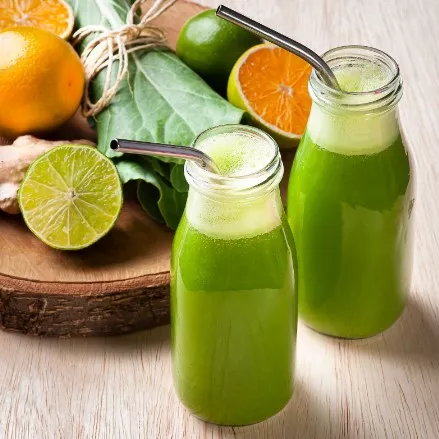Can Chard Be Eaten Raw in a salad or prepared as chard green juice? Yes and yes! In this article, we summarize everything about the Benefits Of Chard Juice, how to improve the taste, and how to prepare it to get the most out of its nutrients.
Let’s start!
Swiss chard (Beta vulgaris ssp. cicla) is a type of edible herbaceous plant belonging to the same species as beets. Unlike the latter, in which the most interesting part of the plant from a culinary point of view would be the root, in the case of chard, it is the leaves that hold the greatest gastronomic attraction. Also, the petioles that support these leaves, are known in cooking as stalks.
Chard is a vegetable with large, succulent, and fleshy leaves, loaded with vitamins and fiber, among many other essential nutrients. In addition, almost 50% of the volume of chard is composed of water and its caloric values are very low, making it an ideal vegetable to incorporate frequently into your dishes if you want to enjoy a healthier diet.
In this article, we are going to spend a few minutes to know a little better about this vegetable native to southern Europe and Asia. A plant that grows spontaneously in many of the regions bathed by the Mediterranean Sea, from where its cultivation has spread throughout the world over the centuries, mainly to other European countries and the United States.
Not surprisingly, the name chard comes from the Greek voice sikelḗ, which means “the Sicilian”, which indicates that the ancient Greeks already rooted the origin of this vegetable in the Latin island.
Today we will show you the main food properties and nutritional composition of chard along with the Benefits Of Chard Juice.
You will also discover which are the most important health benefits that regular consumption of this vegetable can bring you. And finally, you will see some suggestions for preparing chard juice, eating raw chard and cooking chard to bring it to your table most deliciously and healthily possible.
Table of Contents
Properties And Nutritional Value Of Swiss Chard
Chard stands out for its high nutritional value and for being a vegetable that provides a very low caloric content to your diet. They contain a large amount of fiber, so their consumption helps you regulate digestive processes and promotes bowel movements and intestinal transit. They also contain a large number of vitamins -mainly folates, vitamin C, vitamin A, vitamin K, and niacin- and minerals essential for the proper functioning of your body, such as iodine, iron, magnesium, and potassium. The nutritional composition of chard per 100 grams is as follows:
- Caloric intake: 41 kcal
- Protein: 2 g
- Lipids: 0.4 g
- Cholesterol: 0.0 g
- Carbohydrates: 4.5 g
- Water: 87.5 g
- Calcium: 113 mg
- Iron: 3 mg
- Iodine: 35 µg
- Magnesium: 71 mg
- Zinc: 0.02 mg
- Sodium: 147 mg
- Potassium: 550 mg
- Phosphorus: 40 mg
- Selenium: 0.9 µg
- Thiamine: 0.07 mg
- Riboflavin: 0.06 mg
- Niacin equivalents: 2.1 mg
- Folates: 140 µg
- Vitamin C: 20 mg
- Vitamin A: 183 µg
- Vitamin E: 0.03 mg
- Vitamin K: 830 µg

Benefits Of Chard Juice for a Healthy Diet
All these nutrients that chard can bring to your diet make it one of the healthiest vegetables you can bring to your table. And with them come several health benefits.
Let’s see the Benefits Of Chard Juice for a Healthy Diet. Among the most notable positive health effects of chard are the following:
Helps keep your bones and blood healthy
It provides you with a good amount of other essential vitamins.
These include vitamin A, vitamin E, and B group vitamins (B1, B2, B3, B5, B6, and B9), which are essential for the correct performance of your body’s metabolic functions. These last vitamins, the B group vitamins, cannot be stored by your body, so their regular consumption in your diet is recommended.
It is an antioxidant and strengthens your immune system.
Its high vitamin C content makes chard a food with antioxidant properties. Thus, it contributes to neutralizing and eliminating free radicals and stopping their degrading effect on our cells, so eating chard helps you to take care of the health of your skin, hair, and nails and to stop cellular aging in general. In addition, vitamin C is essential for the proper functioning of your immune system.
Provides high amounts of iron to your diet
Helps reduce your fatigue levels and promotes the proper functioning of your muscular system.
This is due to the high magnesium and potassium content that chard can help you incorporate into your diet. The first of these essential minerals helps you level the concentration of sugars in your bloodstream, supports the functioning of your nervous and muscular systems, helps regulate blood pressure, and is involved in the formation of DNA and bone tissue. For all these reasons, adequate levels of magnesium allow your body to function properly and feel good and energetic. Potassium, in your case, is an electrolyte essential for muscle and nerve function. It is also necessary for your heart rate to be maintained at proper levels and for the nutritional and cleansing functions of your body’s cells to take place.
Take care of your cardiovascular system
Thanks to the contribution of chard in omega-3 fatty acids, beta-carotene, alpha-carotene and flavonoid compounds, among other nutrients that help to take care of the health of your heart and blood vessels.
Provides a large amount of fiber to your dishes
This high fiber content helps stimulate bowel movements and facilitates digestive processes. Thus, chard helps regulate your intestinal transit and avoid episodes of constipation. The fiber content of chard also favors the absorption of other nutrients in the intestine and generates a satiating effect.
Recommended Post: 6 Benefits of Consuming Red Chard
Can Chard Be Eaten Raw?
Can Chard Be Eaten Raw? The tender leaves of chard can be eaten raw in salads or made into chard juice.
However, chard stems are not tasty to eat raw. And if the chard has already aged slightly, it can be somewhat bitter. In a salad, it is not easy to correct the flavor, but if it is a chard juice it is easy to add healthy additives to make it tastier.

Chard Juice, Recipes for Eat Raw Chard and Improving Taste
A tasty way to mix flavors when preparing chard juice and get maximum iron absorption in the body is to add a little lemon or orange juice. Lowering the pH of the juice (making it more acidic) will improve the intestinal absorption of iron, as well as make it more palatable. Kiwi is another great option to combine with chard.

The best way to cook chard so that it keeps all its healthy properties intact is to cook it for a short time and at a low temperature. In this way, you will avoid an excessive loss of nutrients during cooking, and you will be able to enjoy all its flavors.
Chard is an ideal vegetable for sautéing for a few minutes in the pan or for steaming.
An effective and surprisingly fast method, fill the pot with water, add salt to taste (it is possible to use other seasonings), and chopped chard. In only 4 minutes after starting the steam expulsion, the chard will be ready and tender to be consumed and give you the maximum of nutrients.
However, if you want to take full advantage of 100% of its nutrients, it is best to incorporate chard into your diet raw, for example, in salads or in the form of juices or smoothies, either alone or together with other fruits and vegetables.

